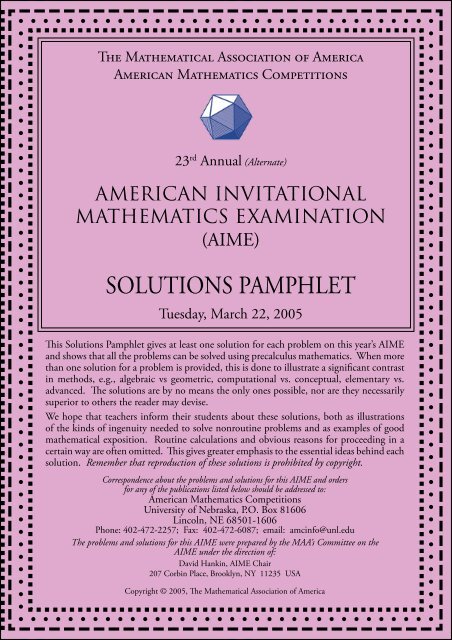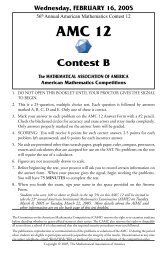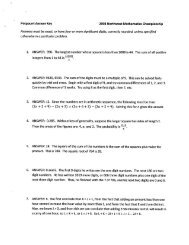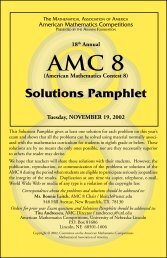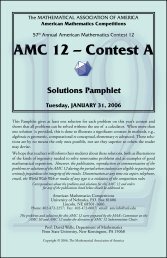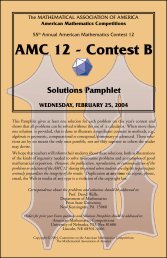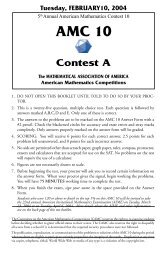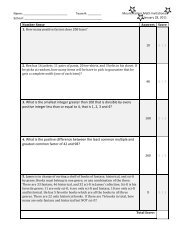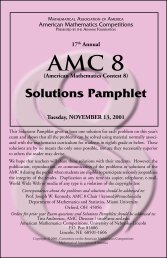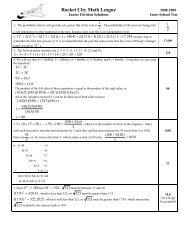answer key link
answer key link
answer key link
You also want an ePaper? Increase the reach of your titles
YUMPU automatically turns print PDFs into web optimized ePapers that Google loves.
The Mathematical Association of America<br />
American Mathematics Competitions<br />
23 rd Annual (Alternate)<br />
AMERICAN INVITATIONAL<br />
MATHEMATICS EXAMINATION<br />
(AIME)<br />
SOLUTIONS PAMPHLET<br />
Tuesday, March 22, 2005<br />
This Solutions Pamphlet gives at least one solution for each problem on this year’s AIME<br />
and shows that all the problems can be solved using precalculus mathematics. When more<br />
than one solution for a problem is provided, this is done to illustrate a significant contrast<br />
in methods, e.g., algebraic vs geometric, computational vs. conceptual, elementary vs.<br />
advanced. The solutions are by no means the only ones possible, nor are they necessarily<br />
superior to others the reader may devise.<br />
We hope that teachers inform their students about these solutions, both as illustrations<br />
of the kinds of ingenuity needed to solve nonroutine problems and as examples of good<br />
mathematical exposition. Routine calculations and obvious reasons for proceeding in a<br />
certain way are often omitted. This gives greater emphasis to the essential ideas behind each<br />
solution. Remember that reproduction of these solutions is prohibited by copyright.<br />
Correspondence about the problems and solutions for this AIME and orders<br />
for any of the publications listed below should be addressed to:<br />
American Mathematics Competitions<br />
University of Nebraska, P.O. Box 81606<br />
Lincoln, NE 68501-1606<br />
Phone: 402-472-2257; Fax: 402-472-6087; email: amcinfo@unl.edu<br />
The problems and solutions for this AIME were prepared by the MAA’s Committee on the<br />
AIME under the direction of:<br />
David Hankin, AIME Chair<br />
207 Corbin Place, Brooklyn, NY 11235 USA<br />
Copyright © 2005, The Mathematical Association of America
2005 AIME 2 SOLUTIONS 2<br />
1. (Answer: 013)<br />
( ( n n n!<br />
The conditions of the problem imply that = 6 , so<br />
6)<br />
3)<br />
6!(n − 6)! = 6 ·<br />
n!<br />
(n − 3)!<br />
. Then = 6!, so (n − 3)(n − 4)(n − 5) = 720 = 10 · 9 · 8. Thus<br />
3!(n − 3)! (n − 6)!<br />
n = 13 is a solution, and because (n − 3)(n − 4)(n − 5) is increasing for n ≥ 5,<br />
conclude that 13 is the only solution for n ≥ 5.<br />
2. (Answer: 079)<br />
The probability that the first bag contains one of each of the three types of rolls<br />
is<br />
(9/9)(6/8)(3/7) = 9/28. The probability that the second bag will then contain<br />
one of each is (6/6)(4/5)(2/4) = 2/5. If the first two bags have a complete selection,<br />
then the last bag must too. Thus the probability that all three breakfasts<br />
have a complete selection is (9/28)(2/5) = 9/70, and m + n = 9 + 70 = 79.<br />
3. (Answer: 802)<br />
Let a be the first term and r the ratio of the original series, and let S = 2005.<br />
a<br />
Then<br />
1 − r = S and a 2<br />
( ) ( )<br />
a a<br />
1 − r 2 = 10S. Factor to obtain 10S = =<br />
1 − r 1 + r<br />
a<br />
a<br />
S · . Then 10 =<br />
1 + r 1 + r and S = a imply that S(1 − r) = 10(1 + r), so<br />
1 − r<br />
r = S − 10 = 1995/2015 = 399/403, and m + n = 802.<br />
S + 10<br />
4. (Answer: 435)<br />
Note that 10 10 = 2 10 5 10 , so it has 11 · 11 = 121 divisors. Similarly, 15 7 = 3 7 · 5 7 ,<br />
so it has 8 · 8 = 64 divisors, and 18 11 = 2 11 3 22 , so it has 12 · 23 = 276 divisors.<br />
There are 8 divisors of both 10 10 and 15 7 , namely those numbers that are divisors<br />
of 5 7 ; there are 11 divisors of both 10 10 and 18 11 , namely those numbers that<br />
are divisors of 2 10 ; and there are 8 divisors of both 15 7 and 18 11 , namely those<br />
numbers that are divisors of 3 7 . There is only one divisor of all three. Therefore,<br />
the Inclusion-Exclusion Principle implies that the number of divisors of at least<br />
one of the numbers is (121 + 64 + 276) − (8 + 11 + 8) + 1 = 435.<br />
5. (Answer: 054)<br />
Let x = log a b. Because log b a = 1/ log a b, the given equation can be written as<br />
x + (6/x) = 5, and because x ≠ 0, this is equivalent to x 2 − 5x + 6 = 0, whose<br />
solutions are 2 and 3. If 2 = x = log a b, then a 2 = b. Now 44 2 = 1936 and<br />
45 2 = 2025, so there are 44 − 1 = 43 ordered pairs (a, b) such that a 2 = b and
2005 AIME 2 SOLUTIONS 3<br />
a and b satisfy the given conditions. If 3 = x = log a b, then a 3 = b. Because<br />
12 3 = 1728 and 13 3 = 2197, there are 12 − 1 = 11 ordered pairs (a, b) such that<br />
a 3 = b and a and b satisfy the given conditions. Thus there are 43 + 11 = 54 of<br />
the requested ordered pairs.<br />
6. (Answer: 392)<br />
Note that, after the restacking, all the cards from pile B occupy even-numbered<br />
positions and their order is reversed. Similarly, all the cards from pile A will be<br />
placed in odd-numbered positions, and their order is also reversed. A card in<br />
position i for 1 ≤ i ≤ n will be moved to position 2(n − i) + 1 in the restacking,<br />
and, for n < i ≤ 2n, the card will be moved to position 2(2n − i) + 2. For a card<br />
to remain in the 131st position, it must be in pile A. Then 131 = 2(n−131)+1,<br />
and 2n = 392. Note that the stack is magical because cards number 131 and<br />
262 retain their original positions.<br />
7. (Answer: 125)<br />
Let y = 16√ 5. Then<br />
x =<br />
4<br />
(y 8 + 1)(y 4 + 1)(y 2 + 1)(y + 1) = 4(y − 1)<br />
(y 8 + 1)(y 4 + 1)(y 2 + 1)(y + 1)(y − 1)<br />
Thus (x + 1) 48 = y 48 = 5 3 = 125.<br />
=<br />
4(y − 1)<br />
y 16 − 1<br />
=<br />
4(y − 1)<br />
5 − 1<br />
= y − 1.<br />
8. (Answer: 405)<br />
The radius of C 3 is 14. Let P 1 , P 2 , and P 3 be the centers of C 1 , C 2 , and C 3 ,<br />
respectively. Draw perpendiculars from P 1 , P 2 , and P 3 to the external tangent<br />
of C 1 and C 2 intersecting it at X, Y , and Z, respectively, so that P 1 X, P 2 Y ,<br />
P 3 Z are parallel, with P 1 X = 4 and P 2 Y = 10. From P 1 , draw a line parallel<br />
to XY intersecting P 3 Z and P 2 Y at Q and R, respectively. Note that P 1 XY R<br />
is a rectangle and that right triangles P 1 P 2 R and P 1 P 3 Q are similar. Then<br />
P 3 Z = P 3 Q + QZ = (10/14) · 6 + 4 = 58/7. Because Z is the midpoint of<br />
the chord, the chord’s length is 2 √ 14 2 − (58/7) 2 = 8 √ 390/7, and m + n + p =<br />
8 + 390 + 7 = 405.<br />
.<br />
X<br />
•<br />
Z<br />
•<br />
•Y<br />
.<br />
•<br />
Q<br />
•R<br />
. •<br />
P1<br />
..<br />
..<br />
•.<br />
•.<br />
P 3 P2
9. (Answer: 250)<br />
Note that<br />
2005 AIME 2 SOLUTIONS 4<br />
(sin t + i cos t) n =<br />
[ ( π<br />
) ( π<br />
)] n<br />
cos<br />
2 − t + i sin<br />
2 − t ( π<br />
) ( π<br />
)<br />
2 − t 2 − t<br />
= cos n<br />
= cos<br />
+ i sin n<br />
( nπ<br />
)<br />
2 − nt + i sin<br />
( nπ<br />
2 − nt )<br />
,<br />
( π<br />
) ( π<br />
)<br />
and that sin nt + i cos nt = cos<br />
2 − nt + i sin<br />
2 − nt . Thus the given condition<br />
is equivalent to<br />
( nπ<br />
) ( π<br />
)<br />
cos<br />
2 − nt = cos<br />
2 − nt<br />
and<br />
( nπ<br />
) ( π<br />
)<br />
sin<br />
2 − nt = sin<br />
2 − nt .<br />
In general, cos α = cos β and sin α = sin β if and only if α − β = 2πk. Thus<br />
nπ<br />
2 − nt − π + nt = 2πk,<br />
2<br />
which yields n = 4k + 1. Because 1 ≤ n ≤ 1000, conclude that 0 ≤ k ≤ 249, so<br />
there are 250 values of n that satisfy the given conditions.<br />
OR<br />
Observe that<br />
(sin t + i cos t) n = [i(cos t − i sin t)] n = i n (cos nt − i sin nt),<br />
sin nt + i cos nt = i(cos nt − i sin nt).<br />
and that<br />
Thus the given equation is equivalent to i n (cos nt−i sin nt) = i(cos nt−i sin nt).<br />
This is true for all real t when i n = i. Thus n must be 1 more than a multiple<br />
of 4, so there are 250 values of n that satisfy the given conditions.<br />
10. (Answer: 011)<br />
Without loss of generality, let the edges of O have length 1. Note that O can be<br />
formed by adjoining two square pyramids at their bases. Consider an altitude<br />
from a vertex of one of these pyramids to the square base. This altitude is<br />
also a leg of a right triangle whose other leg joins the center of the square and<br />
a vertex of the square, and√<br />
whose hypotenuse is an edge of O. The length<br />
of the altitude is therefore 1 2 − (√ 2/2 ) 2 √<br />
= 2/2, and so the volume of O<br />
is 2 · (1/3)(1 2 )( √ 2/2) = √ 2/3. To find the volume of C, consider a triangle,<br />
one of whose vertices P is a vertex of O not on the square and whose other
2005 AIME 2 SOLUTIONS 5<br />
two vertices, Q and R, are midpoints of opposite sides of the square. The line<br />
segment that joins the centers of the faces containing P Q and P R, respectively,<br />
is a diagonal of a face of C. Because these centers are two-thirds of the way from<br />
P to Q and from P to R, respectively, the length of the face diagonal joining<br />
them is two-thirds of QR. But QR = 1, so the length of each of the edges of C is<br />
(2/3)/ √ 2 = √ 2/3. Hence the volume of C is ( √ 2/3) 3 = 2 √ 2/27. The requested<br />
ratio is thus ( √ 2/3)/(2 √ 2/27) = 9/2, so m + n = 11.<br />
OR<br />
The six vertices of O are equidistant from its center, and the diagonals that<br />
join the three pairs of opposite vertices are mutually perpendicular. Without<br />
loss of generality, let the length of each of these three diagonals be 2. It is<br />
possible to place a coordinate system so that the coordinates of the vertices of<br />
O are (1, 0, 0), (−1, 0, 0), (0, 1, 0), (0, −1, 0), (0, 0, 1), and (0, 0, −1). Because O<br />
is composed of two square pyramids, its volume is 2(1/3)( √ 2) 2 · 1 = 4/3. The<br />
vertices of C are the centroids of the faces of O, so the coordinates of the vertices<br />
of C are (±1/3, ±1/3, ±1/3). Thus the length of each of the edges of C is 2/3,<br />
and the volume of C is 8/27. The ratio of the volumes is (4/3)/(8/27) = 9/2, so<br />
m + n = 11.<br />
11. (Answer: 889)<br />
For 1 ≤ k ≤ m − 1, we have a k+1 a k = a k a k−1 − 3. Let b k = a k a k−1 for<br />
1 ≤ k ≤ m. Then b 1 = a 1 a 0 = 72 · 37 = 3 · 8 · 3 · 37 = 3 · 888 and b k+1 = b k − 3.<br />
Hence b 889 = 0 and b k > 0 for 1 ≤ k ≤ 888. Thus a 889 = 0 and m = 889.<br />
12. (Answer: 307)<br />
Let G be the midpoint of AB, let α = m̸ EOG, and let β = m̸ F OG. Then<br />
OG = 450, EG = 450 tan α, F G = 450 tan β, and α + β = 45 ◦ . Therefore<br />
450(tan α + tan β) = 400, so tan α + tan β = 8/9. Notice that tan β = tan(45 ◦ −<br />
α) = 1 − tan α<br />
1 − tan α<br />
. Hence tan α +<br />
1 + tan α 1 + tan α = 8 9 . Simplify to obtain 9 tan2 α −<br />
8 tan α + 1 = 0, and conclude that {tan α, tan β} = {(4 ± √ 7)/9}. Because<br />
BF > AE, conclude that EG > F G, and so α > β. Then tan α = (4 + √ 7)/9<br />
and tan β = (4 − √ 7)/9. Thus<br />
BF = BG − F G = 450 − 450 tan β = 450<br />
(<br />
1 − 4 − √ 7<br />
9<br />
)<br />
= 450<br />
(<br />
5 + √ )<br />
7<br />
9<br />
= 250 + 50 √ 7,
2005 AIME 2 SOLUTIONS 6<br />
so p + q + r = 307.<br />
OR<br />
Draw AO and BO. Then m̸ OAB = 45 ◦ = m̸ EOF , and m̸ OEF = m̸ OAB+<br />
m̸ AOE = 45 ◦ + m̸ AOE = m̸ AOF . Therefore △AF O ∼ △BOE, so<br />
AO<br />
AF = BE . Let BF = x. Then AF = 900 − x and BE = 400 + x. Thus<br />
BO<br />
450 √ 2<br />
900 − x = 400 + x<br />
450 √ , which yields<br />
2<br />
2 · 450 2 = 360000 + 500x − x 2 , and then<br />
x 2 − 500x + 45000 = 0.<br />
Use the Quadratic Formula to obtain x = 250 ± 50 √ 7. Recall that BF > AE,<br />
and so x > (900−400)/2 = 250. Then BF = x = 250+50 √ 7, and p+q+r = 307.<br />
13. (Answer: 418)<br />
Let S(x) = P (x) − x − 3. Because S(17) = −10 and S(24) = −10,<br />
S(x) = −10 + (x − 17)(x − 24)Q(x)<br />
for some polynomial Q(x) with integer coefficients. If n is an integer such that<br />
P (n) = n + 3, then S(n) = 0, and (n − 17)(n − 24)Q(n) = 10. Thus the integers<br />
n − 17 and n − 24 are divisors of 10 that differ by 7. The only such pairs are<br />
(2, −5) and (5, −2). This yields {n 1 , n 2 } = {19, 22}, hence n 1 · n 2 = 418. An<br />
example of a polynomial that satisfies the conditions of the problem is P (x) =<br />
x − 7 − (x − 17)(x − 24).
14. (Answer: 463)<br />
2005 AIME 2 SOLUTIONS 7<br />
Let m̸ BAE = α = m̸ CAD, and let β = m̸ EAD. Then<br />
Similarly,<br />
and so<br />
BD<br />
DC = [ABD] (1/2)AB · AD sin BAD<br />
=<br />
[ADC] (1/2)AD · AC sin CAD = AB<br />
AC<br />
BE<br />
EC = AB sin BAE ·<br />
AC sin CAE = AB<br />
AC · sin α<br />
sin(α + β) ,<br />
BE<br />
EC = AB2 · DC<br />
AC 2 · BD .<br />
sin(α + β)<br />
· .<br />
sin α<br />
Substituting the given values yields BE/EC = (13 2 · 6)/(14 2 · 9) = 169/294.<br />
Therefore BE = (15 · 169)/(169 + 294) = (3 · 5 · 13 2 )/463. Because none of 3, 5,<br />
and 13 divides 463, q = 463.<br />
A<br />
•<br />
α α<br />
β<br />
13 14<br />
•<br />
B<br />
.<br />
.<br />
•<br />
E<br />
15<br />
•.<br />
D<br />
6<br />
.<br />
.<br />
•.<br />
C
15. (Answer: 169)<br />
2005 AIME 2 SOLUTIONS 8<br />
Complete the square to obtain (x+5) 2 +(y−12) 2 = 256 and (x−5) 2 +(y−12) 2 =<br />
16 for ω 1 and ω 2 , respectively. Hence ω 1 is centered at F 1 (−5, 12) with radius<br />
16, and ω 2 is centered at F 2 (5, 12) with radius 4. Let P be the center of the<br />
third circle, and let r be its radius. Then P F 1 = 16 − r and P F 2 = 4 + r.<br />
Thus P is on the ellipse with foci F 1 , F 2 and P F 1 + P F 2 = 20. Therefore the<br />
coordinates of P satisfy<br />
x 2 (y − 12)2<br />
+ = 1,<br />
100 75<br />
which is equivalent to 3x 2 + 4y 2 − 96y + 576 = 300. Because P is on the line<br />
with equation y = ax, conclude that the x-coordinate of P satisifies<br />
(3 + 4a 2 )x 2 − 96ax + 276 = 0.<br />
In order for P to exist, the discriminant of the above quadratic equation must<br />
be nonnegative, that is, (−96a) 2 − 4 · 276 · (4a 2 + 3) ≥ 0. Thus a 2 ≥ 69/100, so<br />
m 2 = 69/100, and p + q = 169.<br />
Note that a attains its minimum when the line with equation y = ax is tangent<br />
to the ellipse.<br />
.<br />
y<br />
ω 1<br />
ω 2<br />
• •<br />
F 1<br />
F 2<br />
P<br />
.<br />
.<br />
.<br />
.<br />
• .<br />
.<br />
x
The<br />
American Invitational<br />
Mathematics Examination (AIME)<br />
is Sponsored by<br />
The Mathematical Association of America<br />
University of Nebraska-Lincoln<br />
Contributors<br />
Akamai Foundation<br />
American Mathematical Association of Two Year Colleges<br />
American Mathematical Society<br />
American Society of Pension Actuaries<br />
American Statistical Association<br />
Art of Problem Solving<br />
Canada/USA Mathcamp<br />
Canada/USA Mathpath<br />
Casualty Actuarial Society<br />
Clay Mathematics Institute<br />
Institute for Operations Research and the Management Sciences<br />
L. G. Balfour Company<br />
Mu Alpha Theta<br />
National Council of Teachers of Mathematics<br />
Pedagoguery Software Inc.<br />
Pi Mu Epsilon<br />
Society of Actuaries<br />
U.S.A. Math Talent Search<br />
W. H. Freeman and Company


